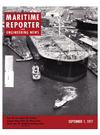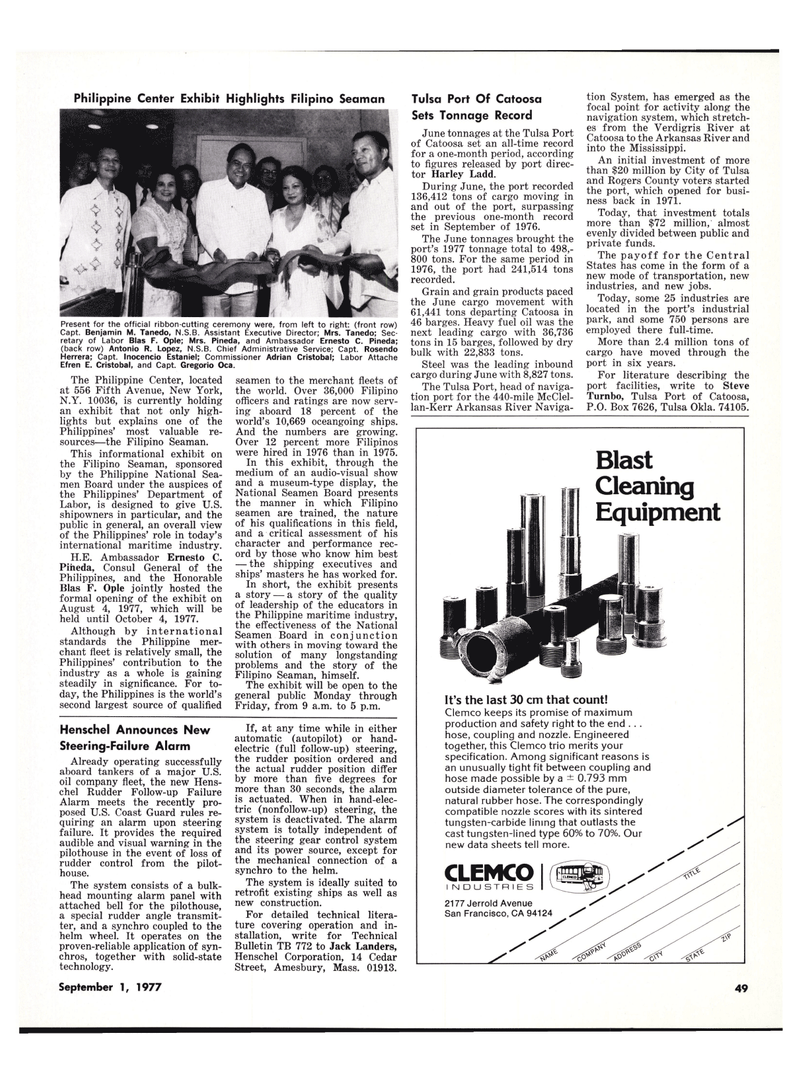
Page 41: of Maritime Reporter Magazine (September 1977)
Read this page in Pdf, Flash or Html5 edition of September 1977 Maritime Reporter Magazine
Philippine Center Exhibit Highlights Filipino Seaman
Present for the official ribbon-cutting ceremony were, from left to right: (front row)
Capt. Benjamin M. Tanedo, N.S.B. Assistant Executive Director; Mrs. Tanedo; Sec- retary of Labor Bias F. Ople; Mrs. Pineda, and Ambassador Ernesto C. Pineda; (back row) Antonio R. Lopez, N.S.B. Chief Administrative Service; Capt. Rosendo
Herrera; Capt. Inocencio Estaniel; Commissioner Adrian Cristobal; Labor Attache
Efren E. Cristobal, and Capt. Gregorio Oca.
The Philippine Center, located at 556 Fifth Avenue, New York,
N.Y. 10036, is currently holding an exhibit that not only high- lights but explains one of the
Philippines' most valuable re- sources—the Filipino Seaman.
This informational exhibit on the Filipino Seaman, sponsored by the Philippine National Sea- men Board under the auspices of the Philippines' Department of
Labor, is designed to give U.S. shipowners in particular, and the public in general, an overall view of the Philippines' role in today's international maritime industry.
H.E. Ambassador Ernesto C.
Pineda, Consul General of the
Philippines, and the Honorable
Bias F. Ople jointly hosted the formal opening of the exhibit on
August 4, 1977, which will be held until October 4, 1977.
Although by international standards the Philippine mer- chant fleet is relatively small, the
Philippines' contribution to the industry as a whole is gaining steadily in significance. For to- day, the Philippines is the world's second largest source of qualified
Henschel Announces New
Steering-Failure Alarm
Already operating successfully aboard tankers of a major U.S. oil company fleet, the new Hens- chel Rudder Follow-up Failure
Alarm meets the recently pro- posed U.S. Coast Guard rules re- quiring an alarm upon steering failure. It provides the required audible and visual warning in the pilothouse in the event of loss of rudder control from the pilot- house.
The system consists of a bulk- head mounting alarm panel with attached bell for the pilothouse, a special rudder angle transmit- ter, and a synchro coupled to the helm wheel. It operates on the proven-reliable application of syn- chros, together with solid-state technology.
September 1, T977 seamen to the merchant fleets of the world. Over 36,000 Filipino officers and ratings are now serv- ing aboard 18 percent of the world's 10,669 oceangoing ships.
And the numbers are growing.
Over 12 percent more Filipinos were hired in 1976 than in 1975.
In this exhibit, through the medium of an audio-visual show and a museum-type display, the
National Seamen Board presents the manner in which Filipino seamen are trained, the nature of his qualifications in this field, and a critical assessment of his character and performance rec- ord by those who know him best — the shipping executives and ships' masters he has worked for.
In short, the exhibit presents a story — a story of the quality of leadership of the educators in the Philippine maritime industry, the effectiveness of the National
Seamen Board in conjunction with others in moving toward the solution of many longstanding problems and the story of the
Filipino Seaman, himself.
The exhibit will be open to the general public Monday through
Friday, from 9 a.m. to 5 p.m.
If, at any time while in either automatic (autopilot) or hand- electric (full follow-up) steering, the rudder position ordered and the actual rudder position differ by more than five degrees for more than 30 seconds, the alarm is actuated. When in hand-elec- tric (nonfollow-up) steering, the system is deactivated. The alarm system is totally independent of the steering gear control system and its power source, except for the mechanical connection of a synchro to the helm.
The system is ideally suited to retrofit existing ships as well as new construction.
For detailed technical litera- ture covering operation and in- stallation, write for Technical
Bulletin TB 772 to Jack Landers,
Henschel Corporation, 14 Cedar
Street, Amesbury, Mass. 01913.
Tulsa Port Of Catoosa
Sets Tonnage Record
June tonnages at the Tulsa Port of Catoosa set an all-time record for a one-month period, according to figures released by port direc- tor Harley Ladd.
During June, the port recorded 136,412 tons of cargo moving in and out of the port, surpassing the previous one-month record set in September of 1976.
The June tonnages brought the port's 1977 tonnage total to 498,- 800 tons. For the same period in 1976, the port had 241,514 tons recorded.
Grain and grain products paced the June cargo movement with 61,441 tons departing Catoosa in 46 barges. Heavy fuel oil was the next leading cargo with 36,736 tons in 15 barges, followed by dry bulk with 22,833 tons.
Steel was the leading inbound cargo during June with 8,827 tons.
The Tulsa Port, head of naviga- tion port for the 440-mile McClel- lan-Kerr Arkansas River Naviga- tion System, has emerged as the focal point for activity along the navigation system, which stretch- es from the Verdigris River at
Catoosa to the Arkansas River and into the Mississippi.
An initial investment of more than $20 million by City of Tulsa and Rogers County voters started the port, which opened for busi- ness back in 1971.
Today, that investment totals more than $72 million, almost evenly divided between public and private funds.
The payoff for the Central
States has come in the form of a new mode of transportation, new industries, and new jobs.
Today, some 25 industries are located in the port's industrial park, and some 750 persons are employed there full-time.
More than 2.4 million tons of cargo have moved through the port in six years.
For literature describing the port facilities, write to Steve
Turnbo, Tulsa Port of Catoosa,
P.O. Box 7626, Tulsa Okla. 74105. 21
Blast
Cleaning
Equipment
It's the last 30 cm that count!
Clemco keeps its promise of maximum production and safety right to the end . . . hose, coupling and nozzle. Engineered together, this Clemco trio merits your specification. Among significant reasons is an unusually tight fit between coupling and hose made possible by a ± 0.793 mm outside diameter tolerance of the pure, natural rubber hose. The correspondingly compatible nozzle scores with its sintered tungsten-carbide lining that outlasts the cast tungsten-lined type 60% to 70%. Our new data sheets tell more.
CLEMCO
I NDUSTRIES 2177 Jerrold Avenue
San Francisco, CA 94124

 40
40

 42
42
